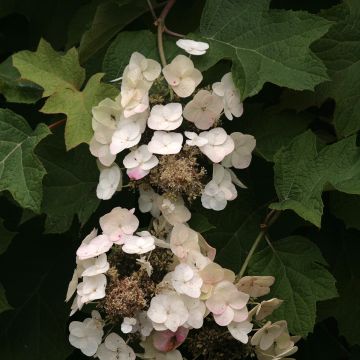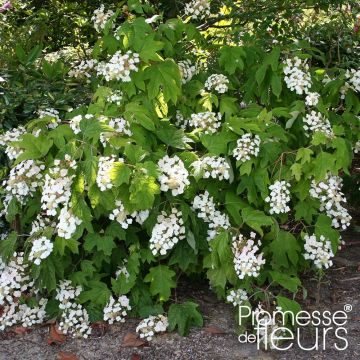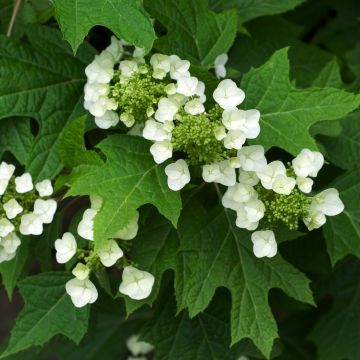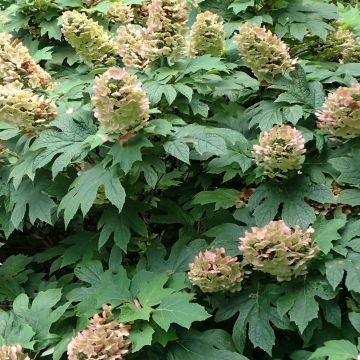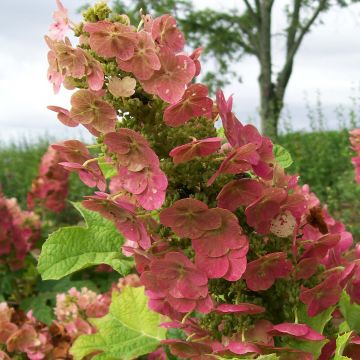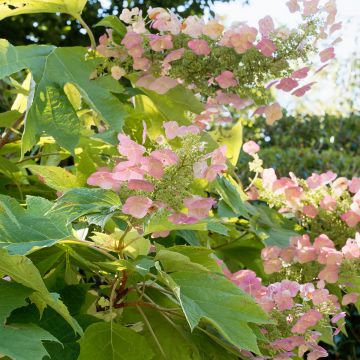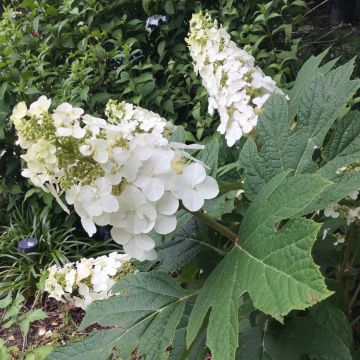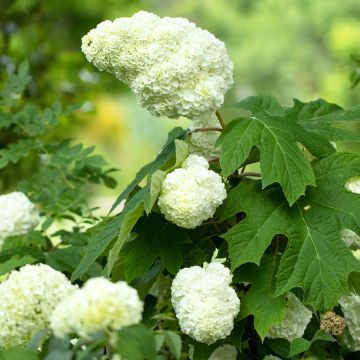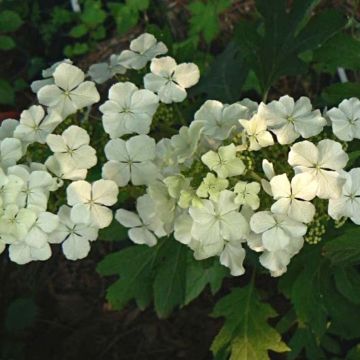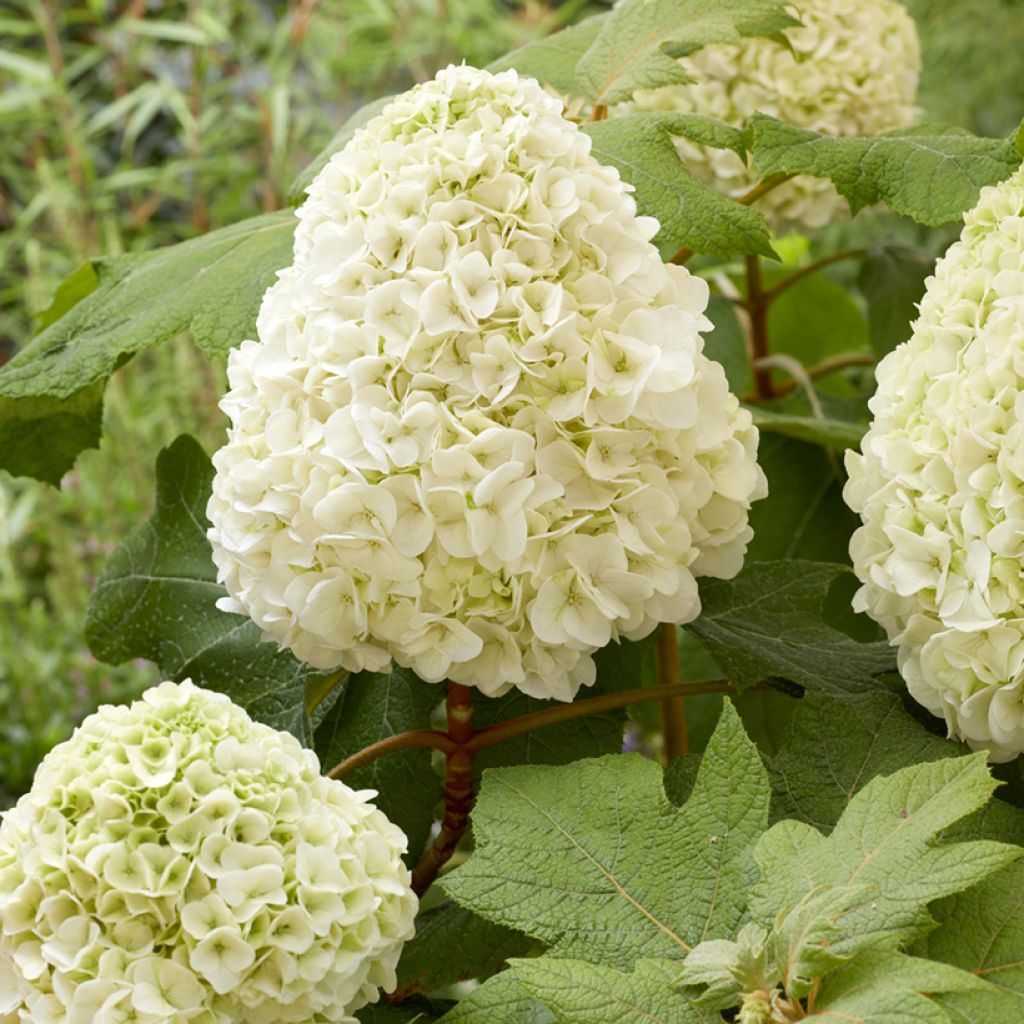

Hydrangea quercifolia Tara
Hydrangea quercifolia Tara
Hydrangea quercifolia Tara® 'BIV01' PP30565
Oakleaf Hydrangea, Oak-leaved Hydrangea
This item cannot be shipped to the selected country
Delivery charge from €5.90
More information
Schedule delivery date,
and select date in basket
This plant carries a 24 months recovery warranty
More information
We guarantee the quality of our plants for a full growing cycle, and will replace at our expense any plant that fails to recover under normal climatic and planting conditions.
From €5.90 for pickup delivery and €6.90 for home delivery
Express home delivery from €8.90.
Does this plant fit my garden?
Set up your Plantfit profile →
Description
The Hydrangea quercifolia Tara 'BIV01' is a variety of oakleaf hydrangea with abundant and dense double-flower panicles with a unique texture. They appear from August onwards, initially green-white and then white. Its beautiful, ample and cut foliage turns bronze and red in autumn. It is a compact selection with solid stems, tolerant of heat, suitable for full sun or partial shade, and adapts to most deep soils.
The Hydrangea quercifolia, from the hydrangea family, is mainly native to the southwestern United States, particularly the Mississippi Valley. It is a large deciduous shrub, reaching a height of 4m (13ft) in its natural habitat and spreading by producing suckers up to 3.50m (11ft) wide. It is characterized by large lobed leaves, which resemble oak leaves. It is appreciated for its superb autumn colours and flowering in large, upright, white panicles composed of small, powdery fertile flowers surrounded by larger sterile florets. In the garden, it is one of the easiest hydrangeas to grow: it is hardy below -20°C (1°F), tolerates some limestone in the soil, and withstands heat and dry soils in summer thanks to its deep rooting.
The Hydrangea quercifolia Tara 'BIV01' is a cultivar selected by Tara Bivin of PDSI (USA). This shrub forms a compact clump with moderate growth, reaching approximately 1.20m (4ft) in all directions at age 10. Its pretty white, slightly curved panicle flowers, 20-25cm (8-10in) long, have a touch of aniseed white. They appear in August and remain beautiful until October. The foliage is deciduous, forming in spring and falling around November. The buds and young leaves are covered with a greyish velvet. The medium to dark green summer foliage comprises large leaves divided into five deep lobes with roughly toothed edges. Towards the end of the season, it takes on beautiful red and bronze hues as the nights cool down.
The Hydrangea quercifolia Tara 'BIV01' is an accommodating hydrangea variety: it tolerates slightly limestone, ordinary, moist to dry soils. Sunlight enhances its beautiful autumn colours, but light shade allows it to take hot climates better. It can be used in borders, as a solitary specimen in a small garden, or in a large pot. Pair it with shrubs with colourful foliage, late-flowering perennials, or evergreen shrubs like Nandina. Also consider purple Berberis, the deciduous winged Euonymus alatus Compactus, which turns bright pink in autumn. Maples and dogwoods are other colourful foliage shrubs to consider. The Verbena hastata Rosea, with its upright spike-like flower heads, also make a beautiful companion.
Report an error about the product description
Plant habit
Flowering
Foliage
Botanical data
Hydrangea
quercifolia
Tara® 'BIV01' PP30565
Hydrangeaceae
Oakleaf Hydrangea, Oak-leaved Hydrangea
Cultivar or hybrid
Other Hydrangea Quercifolia
Planting and care
The 'Tara' hydrangea needs a lot of sunlight to bring out its autumn colours, but it doesn't do well in extremely hot conditions. It's best to plant it in a spot where it will get morning sun or be shaded by a big tree during the hottest part of the day, especially if you live in a sunny and hot region. The plant likes soil that's neutral to acidic and rich in humus, but it can tolerate limestone if you plant it carefully in a hole filled with a mixture of leaf compost and loam. During planting, make sure to put it in soil that's deeply worked, as its roots grow deep to find moisture. To help your plant grow and thrive, give it a good base fertiliser like blood, fish and bone which will give it nutrients without the risk of burning. If your soil tends to be very dry during summer, create a watering basin and mulch the base to keep it moist. Once it's established, the hydrangea doesn't need watering in summer, except in very dry areas where it may appreciate one abundant weekly watering or even every two weeks.
It's best not to cut the dry flower heads in late summer, as they will protect the terminal shoots of the branches in winter. You can cut all the dry flowers at the end of February or when spring looks imminent. The plant's spring vegetation is quite late.
Planting period
Intended location
Care
This item has not been reviewed yet - be the first to leave a review about it.
Haven't found what you were looking for?
Hardiness is the lowest winter temperature a plant can endure without suffering serious damage or even dying. However, hardiness is affected by location (a sheltered area, such as a patio), protection (winter cover) and soil type (hardiness is improved by well-drained soil).

Photo Sharing Terms & Conditions
In order to encourage gardeners to interact and share their experiences, Promesse de fleurs offers various media enabling content to be uploaded onto its Site - in particular via the ‘Photo sharing’ module.
The User agrees to refrain from:
- Posting any content that is illegal, prejudicial, insulting, racist, inciteful to hatred, revisionist, contrary to public decency, that infringes on privacy or on the privacy rights of third parties, in particular the publicity rights of persons and goods, intellectual property rights, or the right to privacy.
- Submitting content on behalf of a third party;
- Impersonate the identity of a third party and/or publish any personal information about a third party;
In general, the User undertakes to refrain from any unethical behaviour.
All Content (in particular text, comments, files, images, photos, videos, creative works, etc.), which may be subject to property or intellectual property rights, image or other private rights, shall remain the property of the User, subject to the limited rights granted by the terms of the licence granted by Promesse de fleurs as stated below. Users are at liberty to publish or not to publish such Content on the Site, notably via the ‘Photo Sharing’ facility, and accept that this Content shall be made public and freely accessible, notably on the Internet.
Users further acknowledge, undertake to have ,and guarantee that they hold all necessary rights and permissions to publish such material on the Site, in particular with regard to the legislation in force pertaining to any privacy, property, intellectual property, image, or contractual rights, or rights of any other nature. By publishing such Content on the Site, Users acknowledge accepting full liability as publishers of the Content within the meaning of the law, and grant Promesse de fleurs, free of charge, an inclusive, worldwide licence for the said Content for the entire duration of its publication, including all reproduction, representation, up/downloading, displaying, performing, transmission, and storage rights.
Users also grant permission for their name to be linked to the Content and accept that this link may not always be made available.
By engaging in posting material, Users consent to their Content becoming automatically accessible on the Internet, in particular on other sites and/or blogs and/or web pages of the Promesse de fleurs site, including in particular social pages and the Promesse de fleurs catalogue.
Users may secure the removal of entrusted content free of charge by issuing a simple request via our contact form.
The flowering period indicated on our website applies to countries and regions located in USDA zone 8 (France, the United Kingdom, Ireland, the Netherlands, etc.)
It will vary according to where you live:
- In zones 9 to 10 (Italy, Spain, Greece, etc.), flowering will occur about 2 to 4 weeks earlier.
- In zones 6 to 7 (Germany, Poland, Slovenia, and lower mountainous regions), flowering will be delayed by 2 to 3 weeks.
- In zone 5 (Central Europe, Scandinavia), blooming will be delayed by 3 to 5 weeks.
In temperate climates, pruning of spring-flowering shrubs (forsythia, spireas, etc.) should be done just after flowering.
Pruning of summer-flowering shrubs (Indian Lilac, Perovskia, etc.) can be done in winter or spring.
In cold regions as well as with frost-sensitive plants, avoid pruning too early when severe frosts may still occur.
The planting period indicated on our website applies to countries and regions located in USDA zone 8 (France, United Kingdom, Ireland, Netherlands).
It will vary according to where you live:
- In Mediterranean zones (Marseille, Madrid, Milan, etc.), autumn and winter are the best planting periods.
- In continental zones (Strasbourg, Munich, Vienna, etc.), delay planting by 2 to 3 weeks in spring and bring it forward by 2 to 4 weeks in autumn.
- In mountainous regions (the Alps, Pyrenees, Carpathians, etc.), it is best to plant in late spring (May-June) or late summer (August-September).
The harvesting period indicated on our website applies to countries and regions in USDA zone 8 (France, England, Ireland, the Netherlands).
In colder areas (Scandinavia, Poland, Austria...) fruit and vegetable harvests are likely to be delayed by 3-4 weeks.
In warmer areas (Italy, Spain, Greece, etc.), harvesting will probably take place earlier, depending on weather conditions.
The sowing periods indicated on our website apply to countries and regions within USDA Zone 8 (France, UK, Ireland, Netherlands).
In colder areas (Scandinavia, Poland, Austria...), delay any outdoor sowing by 3-4 weeks, or sow under glass.
In warmer climes (Italy, Spain, Greece, etc.), bring outdoor sowing forward by a few weeks.

































